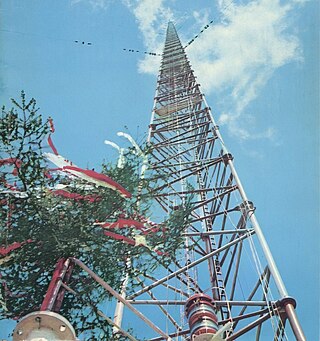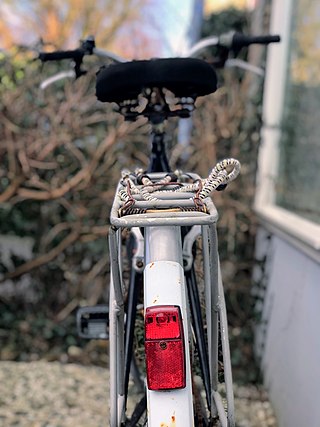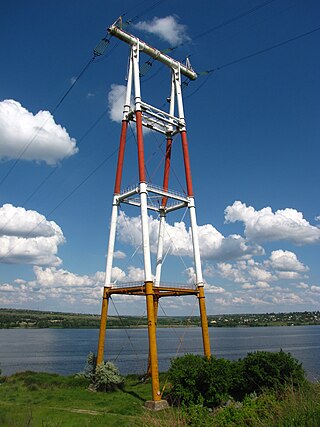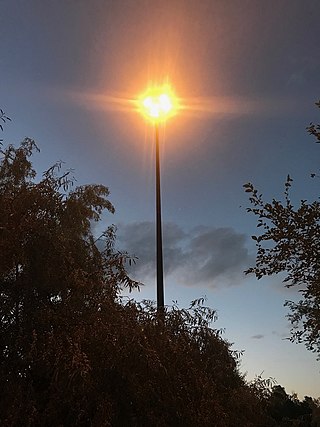
A lighthouse is a tower, building, or other type of physical structure designed to emit light from a system of lamps and lenses and to serve as a beacon for navigational aid for maritime pilots at sea or on inland waterways.

The Warsaw Radio Mast was a radio mast located near Gąbin, Poland, and was the world's tallest structure at 2,120 ft from 1974 until its collapse on 8 August 1991. The mast was designed for extreme height in order to broadcast Communist propaganda around the world, including to the remotest areas such as Antarctica. As of 2023, it was the third-tallest manmade structure ever built, after the Burj Khalifa tower in the United Arab Emirates in 2009, and Merdeka 118 tower in Malaysia in 2022.

Fernsehturm Stuttgart is a 216.61 m (710.7 ft) telecommunications tower in Stuttgart, Germany. It was the first telecommunications tower in the world constructed from reinforced concrete, and it is the prototype for many such towers worldwide. Although controversial at first, it quickly became a well known landmark of Stuttgart and a tourist attraction.

A transmission tower is a tall structure, usually a lattice tower made of steel that is used to support an overhead power line. In electrical grids, transmission towers carry high-voltage transmission lines that transport bulk electric power from generating stations to electrical substations, from which electricity is delivered to end consumers; moreover, utility poles are used to support lower-voltage sub-transmission and distribution lines that transport electricity from substations to electricity customers.

Bicycle lighting is illumination attached to bicycles whose purpose above all is, along with reflectors, to improve the visibility of the bicycle and its rider to other road users under circumstances of poor ambient illumination. A secondary purpose is to illuminate reflective materials such as cat's eyes and traffic signs. A third purpose may be to illuminate the roadway so that the rider can see the way ahead. Serving the latter purposes require much more luminous flux and thus more power.

The Eifel Transmitter is an FM and TV transmission facility for the German broadcasting company of SWR and is located on the Scharteberg near Kirchweiler, Germany. Until 1985, the Scharteberg transmitter used a 160 metre tall guyed mast. However this mast did not allow good reception in deep valleys, so in 1985 a new, 302 metre tall, guyed, steel framework mast was built, becoming the tallest structure of Rhineland-Palatinate. The elements of this mast were built by the firm of Hein, Lehmann AG, whilst construction work was carried out by BBS AG, Ludwigshafen. The first 20 metres of the mast were built using a small crane. The mast elements in heights between 20 and 100 metres were mounted by the aid of a car crane, while for the sections above a derrick crane was used. The new mast of Scharteberg transmitter consists of a 288 metre tall, guyed, lattice, steel structure with a square cross section, a side length of 2.1 metres and a 14 metre long GFK-cylinder on top for the UHF antenna. The total weight of the structure is 204 tons. The mast is guyed at 4 levels, 57, 123, 195 and 273 metres above ground. It is equipped with an elevator which runs up to a height of 281 metres. For aircraft warning 20 red neon lamps and two blinking lights with 1000 watt lamps are installed.

An overhead line crossing is the crossing of an obstacle—such as a traffic route, a river, a valley or a strait—by an overhead power line. The style of crossing depends on the local conditions and regulations at the time the power line is constructed. Overhead line crossings can sometimes require extensive construction and can also have operational issues. In such cases, those in charge of construction should consider whether a crossing of the obstacle would be better accomplished by an underground or submarine cable.

The Arfon transmitting station is a facility for FM, DAB digital radio and television transmission near the villages of Nebo and Nasareth in Gwynedd, northwestern Wales. It includes a 308.5 m (1,012 ft) guyed mast with antennas attached at various heights. The mast is surmounted by a television transmitting antenna, which brings the total height of the structure to 317.4 m (1,041 ft), making it the tallest structure in Wales. It is owned and operated by Arqiva.

The sulfur lamp is a highly efficient full-spectrum electrodeless lighting system whose light is generated by sulfur plasma that has been excited by microwave radiation. They are a particular type of plasma lamp, and one of the most modern. The technology was developed in the early 1990s and appeared promising, but was not a commercial success by the late 1990s. Since 2005, lamps are again being manufactured for commercial use.

Radio masts and towers are typically tall structures designed to support antennas for telecommunications and broadcasting, including television. There are two main types: guyed and self-supporting structures. They are among the tallest human-made structures. Masts are often named after the broadcasting organizations that originally built them or currently use them.

A mast radiator is a radio mast or tower in which the metal structure itself is energized and functions as an antenna. This design, first used widely in the 1930s, is commonly used for transmitting antennas operating at low frequencies, in the LF and MF bands, in particular those used for AM radio broadcasting stations. The conductive steel mast is electrically connected to the transmitter. Its base is usually mounted on a nonconductive support to insulate it from the ground. A mast radiator is a form of monopole antenna.

Emergency vehicle equipment is any equipment fitted to, or carried by, an emergency vehicle, other than the equipment that a standard non-emergency vehicle is fitted with.

Aviation obstruction lighting is used to enhance the visibility of structures or fixed obstacles which may conflict with the safe navigation of aircraft. Obstruction lighting is commonly installed on towers, buildings, and even fences located in areas where aircraft may be operating at low altitudes. In certain areas, some aviation regulators mandate the installation, operation, color, and/or status notification of obstruction lighting. For maximum visibility and collision-avoidance, these lighting systems commonly employ one or more high-intensity strobe or LED devices which can be seen by pilots from many miles away from the obstruction.
This article describes the graphic conventions used in Sectional charts and Terminal area charts published for aeronautical navigation under Visual Flight Rules in the United States of America. The charts are published "in accordance with Interagency Air Cartographic Committee specifications and agreements, approved by the Department of Defense and the Federal Aviation Administration".

Kõpu Lighthouse is one of the best-known symbols and tourist sites on the Estonian island of Hiiumaa. It is located in the village of Mägipe. It is one of the oldest lighthouses in the world, having been in continuous use since its completion in 1531. The lighthouse is quite unique with its shape and exceptional among lighthouses because it has gone through all the stages from a medieval landmark up to a modern electrified lighthouse.

Landing lights are lights, mounted on aircraft, that illuminate the terrain and runway ahead during takeoff and landing, as well as being used as a collision avoidance measure against other aircraft and bird strikes. Landing lights must be activated when the aircraft is under 10,000 feet in altitude.
The Galich Transmitter was an unfinished facility for FM and TV broadcasting near Galich in Russia at 58°26'27"N 42°37'43"E. The 350 meter tall mast was built in 1991 as a lattice steel structure with square cross section, guyed in 4 directions. However, the nearby transmitter building remained unfinished due to the fall of the Soviet Union and subsequent financial difficulties.

High-mast lighting is a tall pole with lighting attached to the top pointing towards the ground, usually but not always used to light a highway or recreational field. It is used at sites that require lighting over a large area. The pole that the lighting is mounted on is generally at least 30 m (98 ft) tall, while the lighting consists of a luminaire ring surrounding the pole with one or several independent lighting fixtures mounted around it. Most units have four, six or eight lights in the ring, with three, five, ten, twelve and sixteen lights used in rarer instances. While most high-mast lights are high-pressure sodium, other lamp types such as mercury vapor, metal halide and LED, have also been used. Some units have the lighting surrounded by a circular shield to prevent or reduce light pollution or light trespass from affecting neighborhoods adjacent to the highway. Maintenance of these systems is done by lowering the luminaire ring from the mast head to the base using a winch and motor to the ground or at a height accessible by a cherry picker and located in areas to allow for easier access without disrupting traffic.
A Wells light was a large paraffin-fuelled (kerosene) blowlamp used for engineering work, particularly for illumination, in Victorian times. At a time before widespread electrical lighting, they were the most common form of high-powered portable illumination used for construction work, particularly railways, civil engineering, shipyards and ironworks.
















